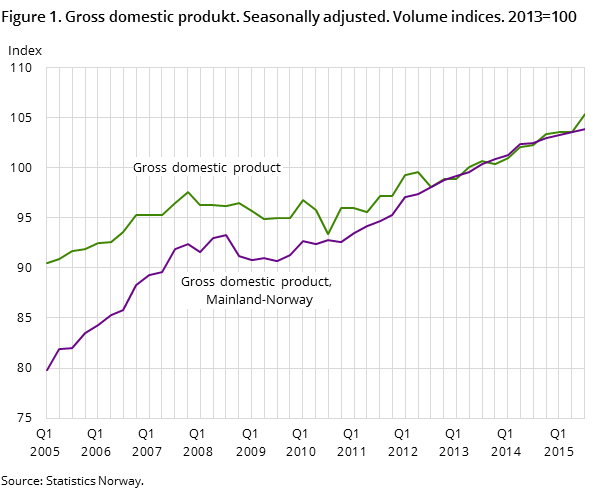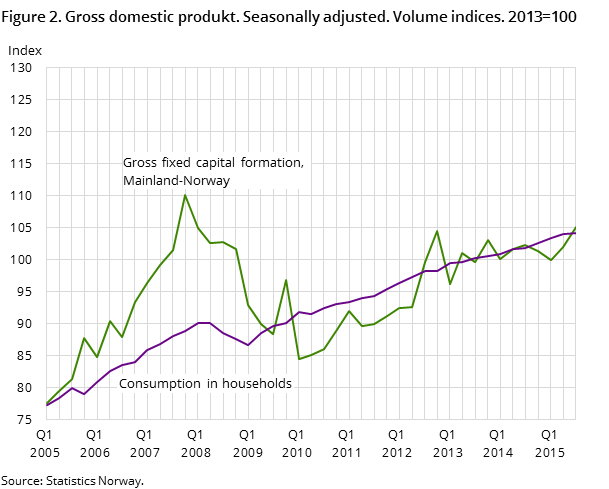Content
Published:
This is an archived release.
Weak growth in GDP Mainland Norway
According to seasonally-adjusted figures, the gross domestic product for Mainland Norway rose by 0.2 per cent in the 3rd quarter of 2015. Since the second half of 2014, growth in the mainland economy has been weak. Industries supplying the petroleum industry experienced a decline in production.
| 2014 | 4th quarter 2014 | 1st quarter 2015 | 2nd quarter 2015 | 3rd quarter 2015 | |
|---|---|---|---|---|---|
| 1Figures from 2014 onwards are preliminary. | |||||
| Gross domestic product | 2.2 | 1.1 | 0.2 | 0.0 | 1.8 |
| Gross domestic product Mainland Norway | 2.3 | 0.4 | 0.3 | 0.3 | 0.2 |
| Petroleum activities and ocean transport | 2.0 | 3.6 | -0.5 | -1.0 | 7.5 |
| Final domestic use of goods and services | 2.0 | -1.2 | 2.4 | -1.1 | -0.8 |
| Final consumption expenditure of households and NPISH | 1.7 | 0.7 | 0.7 | 0.6 | 0.1 |
| Final consumption expenditure of general government | 2.9 | 0.6 | 0.2 | 0.7 | 0.6 |
| Gross fixed capital formation (GFCF) | 0.0 | -2.8 | -0.9 | 0.1 | 0.2 |
| Total exports | 2.2 | 4.5 | -2.8 | 0.3 | 4.6 |
| Total imports | 1.5 | -1.4 | 2.8 | -2.8 | -2.3 |
| Employed persons | 1.1 | 0.1 | 0.1 | 0.3 | 0.2 |
| Total hours worked | 1.5 | 0.2 | 0.0 | 0.2 | 0.1 |


Value added in manufacturing and mining has declined since the 4th quarter of 2014. In this year’s 3rd quarter, the decrease was 2.5 per cent. On its own, the decrease in manufacturing has dampened the growth in GDP Mainland Norway by 0.2 percentage points. The development is characterised in particular with a decline in production among suppliers to the petroleum industry. Similarly, we see a sharp decline in the service industries supplying the petroleum industry, where the decline began in early 2014.
We see, however, positive growth in export-oriented industries and several service industries. Among other things, there has been good growth in hotels and restaurants. Service industries excluding general government increased overall by 0.3 per cent from the 2nd to the 3rd quarter, following a similar decline in the previous quarter. The activity in general government increased by 0.2 per cent in the third quarter, which is a slightly weaker growth than in the previous quarters.
There was strong growth in construction, which increased 3 per cent in the third quarter, after strong growth through 2015. The construction industry contributed to pulling up the growth in GDP Mainland Norway by 0.2 percentage points in the third quarter. There was, however, a slight decline in traditional fishing, while production in aquaculture increased slightly from an already high level. Overall, goods-producing industries excluding manufacturing and mining increased by 1.6 per cent in the 3rd quarter.
Strong growth in production of natural gas resulted in output growth of 7.4 per cent in petroleum activities. Along with the increase in ocean transport, this contributed to the growth in total GDP increasing by 1.8 per cent.
Approximately unchanged consumption
After three quarters of moderate growth, household consumption was roughly unchanged from the 2nd to the 3rd quarter of 2015. Consumption of goods fell by 0.6 per cent in the 3rd quarter, following solid growth in the previous quarter. The largest contribution to the decline was from the fall in purchases of cars etc. Consumption of services increased by 0.9 per cent in the 3rd quarter.
Household consumption abroad grew by 0.5 per cent in the third quarter; the same as the previous quarter, following strong growth in the 1st quarter of 2015.
General government consumption rose by 0.6 per cent. Consumption growth in local government and in central government was 0.9 and 0.3 per cent respectively.
Decreased investments
Gross fixed capital formation (GFCF) in the petroleum industry has fallen since autumn 2013, and the preliminary figures for the 3rd quarter showed the largest decline until now, with a fall of 7.6 per cent.
GFCF in manufacturing and mining was 3.3 per cent lower in the 3rd quarter than in the previous quarter. An increase in investment in some resource-based industries, such as chemical raw materials, helped dampen the decline in manufacturing GFCF. Among other goods-producing industries, however, GFCF increased in the 3rd quarter as a result of increased investments in electricity supply.
GFCF in general government increased by nearly 14 per cent in the 3rd quarter. Household investments in dwellings grew by 2.3 per cent following a similar growth in the two previous quarters.
Increased exports of traditional goods
Exports of traditional goods have consistently increased since the 1st quarter of 2014. In the 3rd quarter of 2015, the increase was 1.6 per cent.
Imports of traditional goods fell by 3.6 per cent in the third quarter following a decline in the previous quarter.
Employment growth
From the 2nd to the 3rd quarter of 2015, employment increased by 0.2 per cent, or about 6 800 people, while the increase in the 2nd quarter was approximately 8 000.
Number of hours worked has increased somewhat less than employment throughout 2015. In the 3rd quarter, hours worked were 0.1 per cent higher than in the 2nd quarter.
Figures for 2014 and 2015 have been revised
In connection with the release of figures for the 3nd quarter, the base year has been updated with new information from the final national accounts for 2013. In addition, new information has been incorporated for all quarters from the 1st quarter of 2014. The new figures for 2014 show a growth in GDP mainland Norway at 2.3 per cent, which is 0.1 percentage point higher than the previous estimate. Household consumption is adjusted slightly down, while public consumption is adjusted accordingly. The seasonally-adjusted Mainland GDP growth in the 2nd quarter of 2015 has been revised upwards from 0.2 to 0.3 per cent.
For an overview of the revisions in the main aggregates in the last quarters, see table 48.
For more information on compilation methods and seasonal adjustment practice, see About the statistics and On seasonal adjustment of the quarterly national accounts.
For an overview of the development in the GDP of some of our trading partners, refer to the link to OECD statistics under Other websites.
Concepts and definitions in National AccountsOpen and readClose
For more information about definitions of the main concepts, variables and classifications in national accounts, see About the statistics, definitions.
How the figures are calculatedOpen and readClose
The sum of four quarters in the Quarterly National Accounts (QNA) makes up the preliminary annual figures until the Annual National Accounts (ANA) for year t are published in November in year t+2 and incorporated as a new base year in the QNA.
Note that in the time series in volume, the figures from the base year and onwards are fixed price figures, while data prior to the base year are chained volume figures. This implies that additivity in volume is lost prior to the base year.
Contact
-
Pål Sletten
E-mail: pal.sletten@ssb.no
tel.: (+47) 99 29 06 84
-
Ingunn Sagelvmo
E-mail: ingunn.sagelvmo@ssb.no
tel.: (+47) 40 90 26 32
-
Pia Tønjum
E-mail: pia.tonjum@ssb.no
tel.: (+47) 48 99 12 07
-
Kristian Gimming
E-mail: kristian.gimming@ssb.no
tel.: (+47) 91 88 39 06
